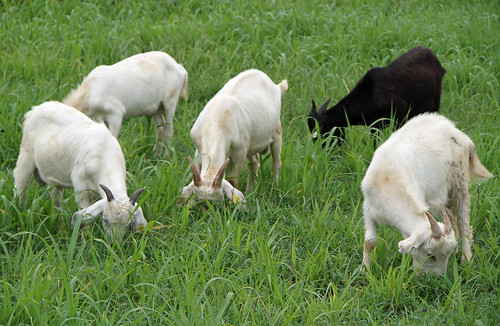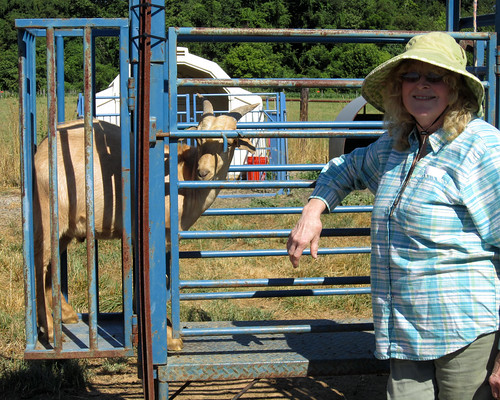While various changes were discussed for 2012, this year's test will be largely the same as last year.
Parasite challenge
Some consigners expressed concern about artificially challenging the goats with worms. Upon arrival, the goats will be dewormed with moxidectin, albendazole, and levamisole. Hopefully, this triple-treatment will reduce the worm load to near zero. This is important so that the goats can start the test equally with regards to parasite infection.
Then, on June 21, the goats will be dosed with 1,000 third stage larvae (L3) of Haemonchus contortus (barber pole worm). This very low dose is not enough to cause clinical parasitism. In fact, 10,000 L3 failed to cause clinical parasitism in lambs at Virginia Tech.
The purpose of giving the goats a small dose of infective larvae is to "seed" the pastures with anthelmintic-susceptible worms. In order to separate the resistant and susceptible bucks, a significant parasite challenge is necessary. In recent years, the parasite challenge has been lacking, though last year's goats experienced some high egg counts at the end of the test.
The larvae are being provided by Dr. Anne Zajac's lab at the VA-MD Regional College of Veterinary Medicine. According to Dr. Zajac, the larvae are susceptible to common anthelmintics.
No anonymous consignments
At one point, it was suggested that consignments be anonymous. While this change offered some potential advantages, it did not have widespread support. Thus, all goats in the test will be identified with their consigners. In contrast, the goats in the pen vs. pasture study will be anonymous. Knowing the consigner is irrelevant to the study. The purpose of the study is to compare the two groups of goats to each other.
Repeat weighings
Consistent with other performance tests, we will weigh the goats twice at the beginning and end of the test. Starting weights will be determined June 14-15. Ending weights will be determined two days the week of September 6-7. The weights will be averaged to determine starting and ending weights.
Sale
On Saturday, September 15, we will have a sale of the top-performing bucks. The sale will be held at the same location as the test: the Western Maryland Research & Education Center. A field day will not be held in conjunction with this year's sale, as last year's field day was very poorly attended.
Hooves
In this year's test, we'd like to pay more attention to hoof growth and health. We feel that this is an important "fitness" trait. Please make sure your bucks have properly trimmed hooves before they arrive on June 2.
We have a new person who will be taking care of the goats on a daily basis. Jeanne Dietz-Band stepped down after six years.
The input from consigners and the purchasers of the bucks is valued. Please feel free to contact a member of the goat test team with your ideas or concerns.
Parasite challenge
Some consigners expressed concern about artificially challenging the goats with worms. Upon arrival, the goats will be dewormed with moxidectin, albendazole, and levamisole. Hopefully, this triple-treatment will reduce the worm load to near zero. This is important so that the goats can start the test equally with regards to parasite infection.
Then, on June 21, the goats will be dosed with 1,000 third stage larvae (L3) of Haemonchus contortus (barber pole worm). This very low dose is not enough to cause clinical parasitism. In fact, 10,000 L3 failed to cause clinical parasitism in lambs at Virginia Tech.
 |
| We're hoping to "seed" the pastures with anthelmintic-susceptible worms! |
The purpose of giving the goats a small dose of infective larvae is to "seed" the pastures with anthelmintic-susceptible worms. In order to separate the resistant and susceptible bucks, a significant parasite challenge is necessary. In recent years, the parasite challenge has been lacking, though last year's goats experienced some high egg counts at the end of the test.
The larvae are being provided by Dr. Anne Zajac's lab at the VA-MD Regional College of Veterinary Medicine. According to Dr. Zajac, the larvae are susceptible to common anthelmintics.
No anonymous consignments
At one point, it was suggested that consignments be anonymous. While this change offered some potential advantages, it did not have widespread support. Thus, all goats in the test will be identified with their consigners. In contrast, the goats in the pen vs. pasture study will be anonymous. Knowing the consigner is irrelevant to the study. The purpose of the study is to compare the two groups of goats to each other.
Repeat weighings
Consistent with other performance tests, we will weigh the goats twice at the beginning and end of the test. Starting weights will be determined June 14-15. Ending weights will be determined two days the week of September 6-7. The weights will be averaged to determine starting and ending weights.
Sale
On Saturday, September 15, we will have a sale of the top-performing bucks. The sale will be held at the same location as the test: the Western Maryland Research & Education Center. A field day will not be held in conjunction with this year's sale, as last year's field day was very poorly attended.
Hooves
In this year's test, we'd like to pay more attention to hoof growth and health. We feel that this is an important "fitness" trait. Please make sure your bucks have properly trimmed hooves before they arrive on June 2.
 |
| Special thanks to Jeanne Dietz-Band for her many years of service to the test. |
We have a new person who will be taking care of the goats on a daily basis. Jeanne Dietz-Band stepped down after six years.
The input from consigners and the purchasers of the bucks is valued. Please feel free to contact a member of the goat test team with your ideas or concerns.











